Per Denton Central Appraisal District, property tax assessments for the amount of increase was closely linked to the value range, but tax assessments for commercial properties grew tremendously. The property tax assessments of Denton County homes increased 5.9% with $155 billion market value and commercial properties saw a more substantial increase of approximately 26.4% with $59 billion market value.
Denton CAD 2025 Reassessment for Homes – 5.9% Overall Increase
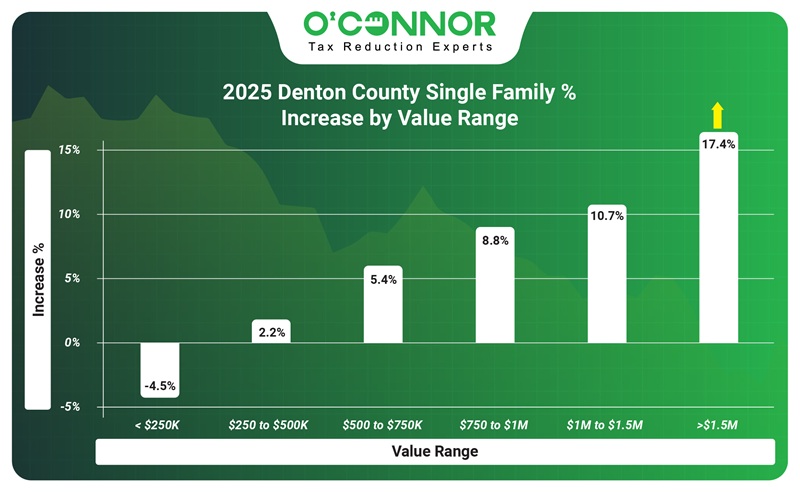
Denton County property tax assessments by range of value show a clear trend: assessment hikes are directly proportional to house value rises. Lower-value homes experienced smaller changes, with some even seeing decreases, while higher-value properties faced the most substantial growth. The assessed value of homes with a value of $250,000 or less dropped 4.5%. Meanwhile, properties priced between $500k and $750k recorded a 5.4% increase. Homes valued between $1 million and $1.5 million saw a 10.7% rise, and properties exceeding $1.5 million experienced an average increase of 17.4%.
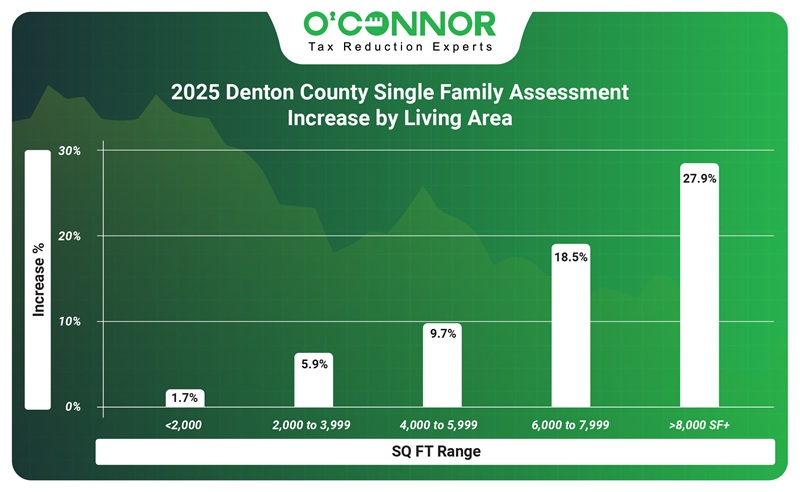
Larger houses in Denton County had the most increases in property values per square foot, however all home sizes saw increases. A clear trend emerged: as home size increased, so did the rate of value growth. Houses with 2,000 to 3,999 square feet of living space increased by 5.9%, while those with 6,000 to 7,999 square feet of living space increased by 18.5%. Homes over 8,000 square feet had the highest jump, with values increasing by 27.9%, bringing the 2025 notice market value to $1.422 billion.
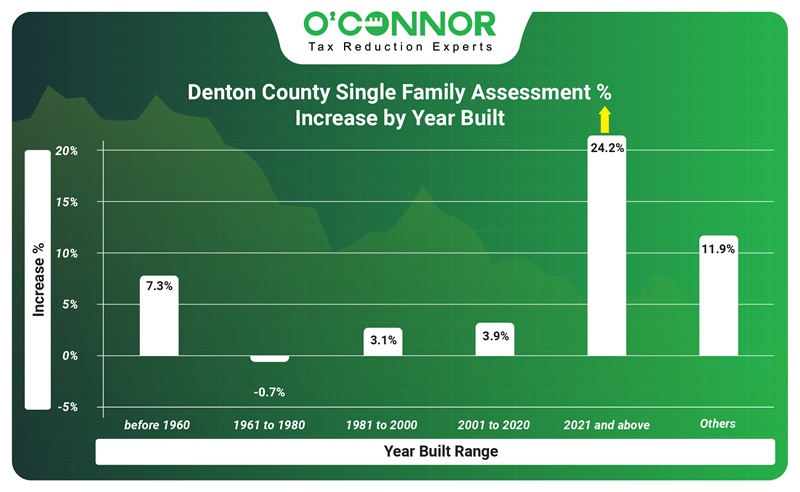
For single family homes per year built, the graph shows no clear correlation. Per Denton CAD, homes built before 1960 increased by 7.3%, while homes built between 1961 to 1980 declined by 0.7%. Homes built between 2001 to 2020 increased modestly by 3.9% and homes built after 2021 had the greatest increase of 24.2%. The market value grew from $146 billion in 2024 to $155 billion in 2025.
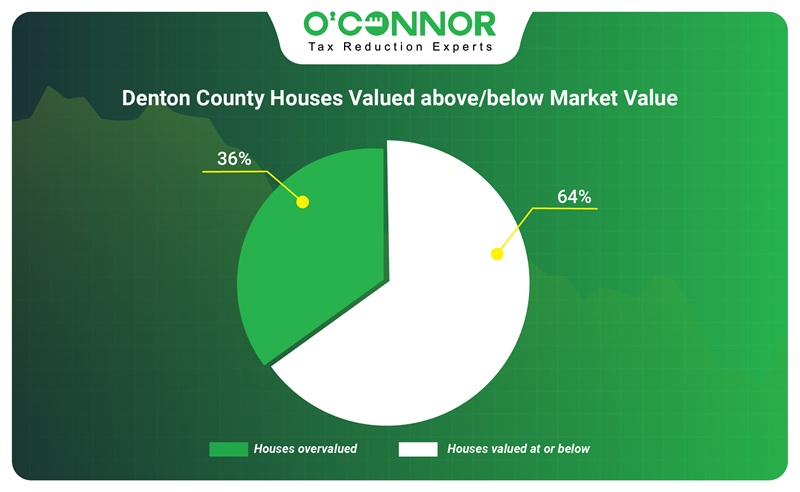
In 2025, 36% of the properties in the county were overvalued by Denton CAD, and 64% of the homes were assessed at values that were lower than their market value. There were 4,463 houses that were overvalued and 7,824 houses that were valued at or below market.
Commercial Property Tax Assessments in Denton CAD Overall Grew by 26.4% in 2025
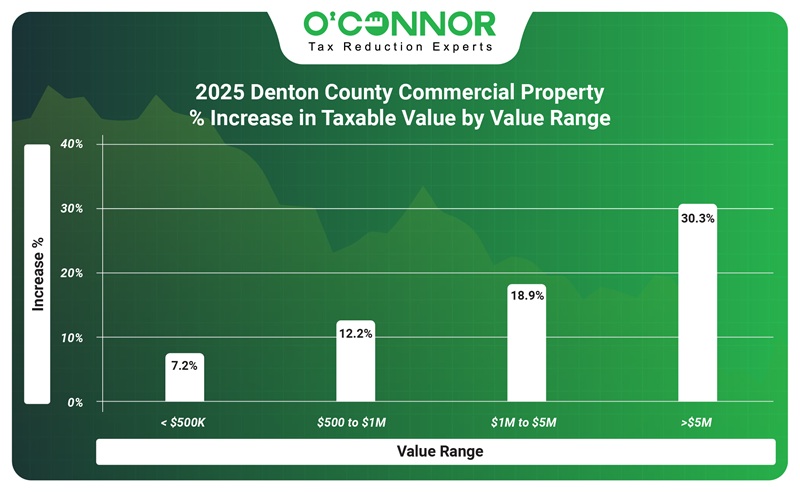
An analysis of commercial property tax assessments by value range in Denton County shows a positive correlation: lower-value properties experienced smaller assessment increases, while higher-value properties saw larger ones. The data indicates that as property values rise, so do the assessment increases. Commercial properties valued under $500,000 saw a 7.2% increase, while those valued between $500,000 and $1 million experienced a 12.2% rise. The highest increase, 30.3%, occurred among properties valued over $5 million.
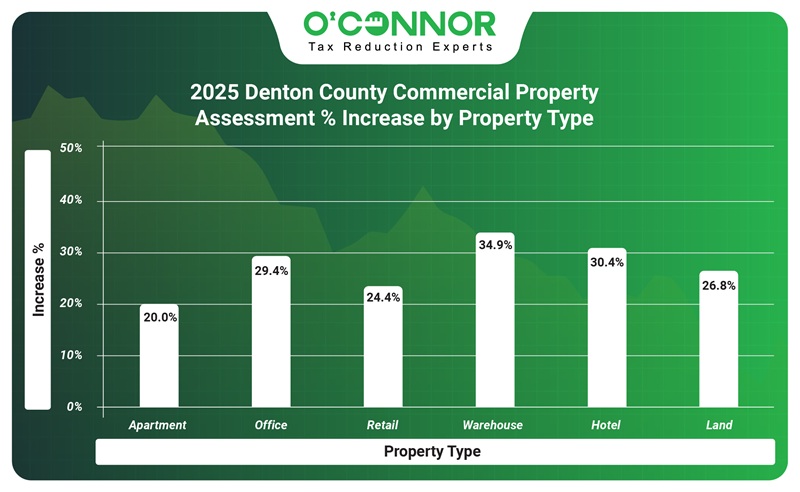
Denton CAD increased the market value for 2025 of all types of commercial properties, with the most significant growth seen in warehouses by 34.9%, followed by hotels with 30.4%. Retail and offices increased by 24.4 and 29.4%, respectively. Apartments had the lowest increase of 20%.
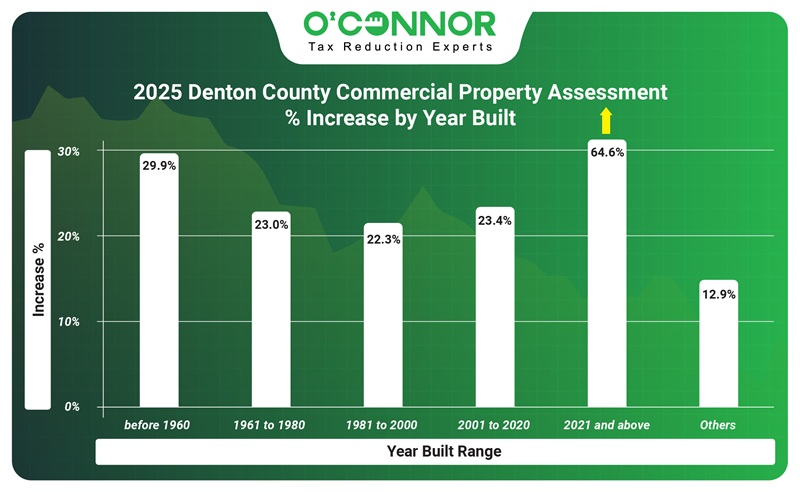
In 2025, per Denton CAD, commercial property assessments increased for all the years built. Interestingly, property built before 1960, and in 2021 and later had the highest increases. Property built before 1960 increased by 29.9% and property built after 2021 increased by 64.6%. Property built between 2001 to 2020 grew from $20 billion to $25 billion, a 23.4% growth. The lowest increase was 22.3%, belonging to property built between 1981 to 2000.
Denton CAD Property Increase vs Market Value Trends
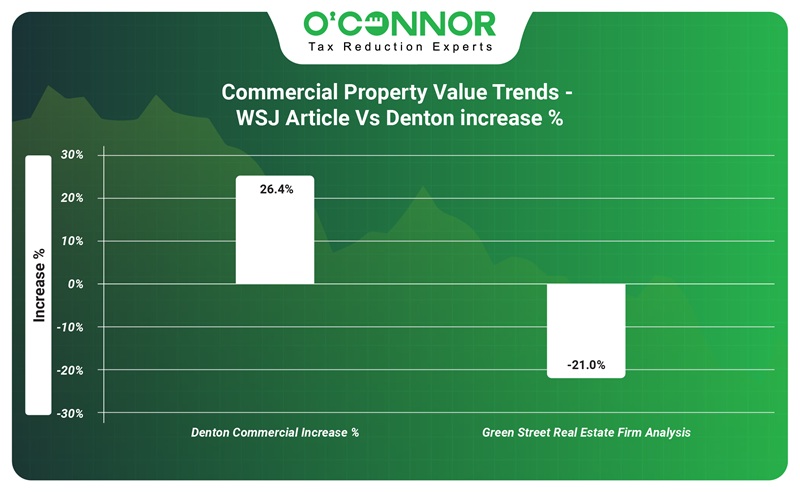
When compared to the findings of the Wall Street company Green Street Real Estate Advisors, Denton CAD’s 2025 commercial property tax reassessment is almost diametrically opposed. According to Green Street Advisors, values have fallen 21% from their 2022 high. In comparison, Denton CAD reported that values are up by 26.4%.
Apartment Buildings in 2025 increased by 20% Per Denton CAD Tax Assessments
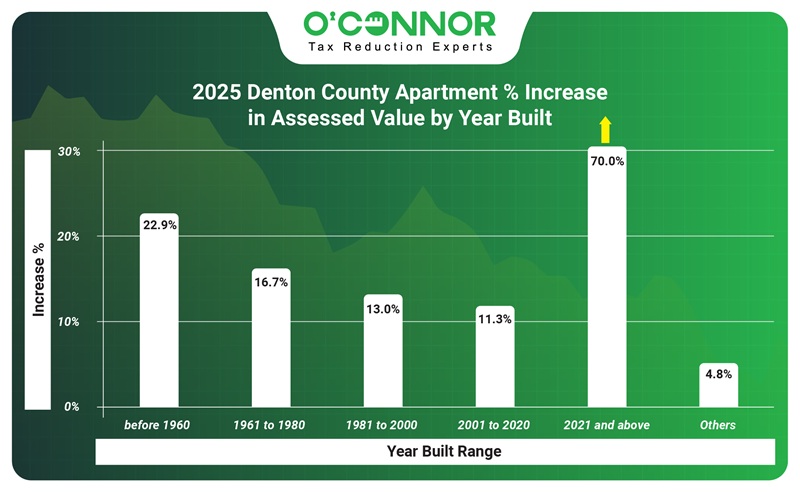
In Denton County, Texas, for the year 2025, the graph shows that the link between the year of an apartment’s construction and the growth in its property tax assessment is mixed. For the early years, it appears the newer the home, the lower the increase; however, apartments built in 2021 and later saw the greatest increase. Apartments built before 1960 increased by 22.9%, while those built between 1981 to 2000 increased by 13%. Apartments built in 2021 and later grew by 70% and the 2025 notice market value was $19.648 billion.
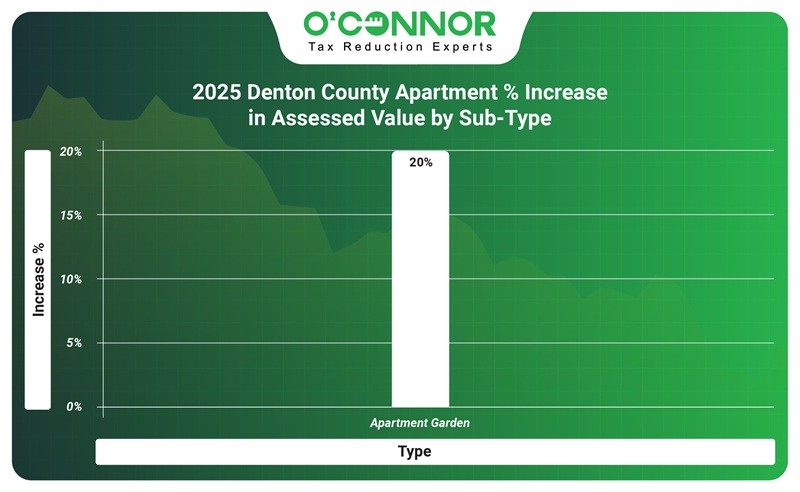
For Denton County, there is only one sub-type for apartments. Apartment gardens increase by 20% in 2025, growing from $16.374 billion to $19.648 billion.
Tax Assessments for Office Properties in 2025 increased by 29.4% according to Denton CAD
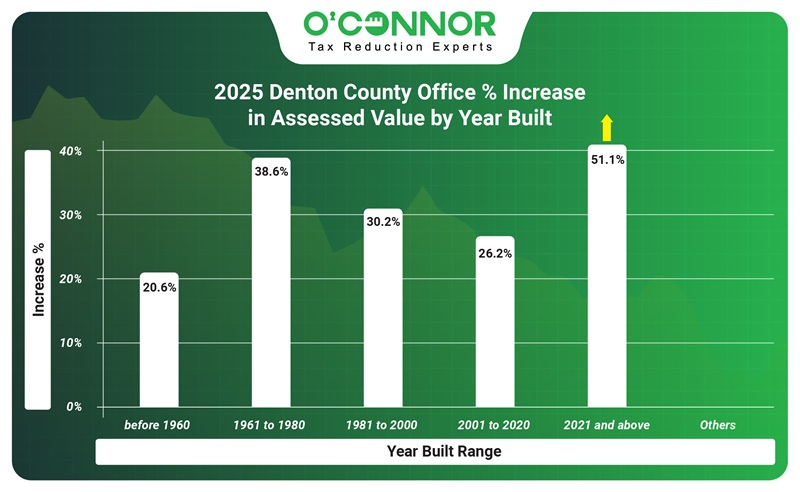
According to Denton CAD, across the board offices built in different years categories increased greatly. The greatest increase was shown in office property built in 2021 and later with 51.1%. Office buildings built before 1960 saw the lowest increase of 20.6%. Notably, property built between 1961 to 1980 also increased tremendously with 38.6%, growing from $245 million to $340 million in the 2025 notice market value.
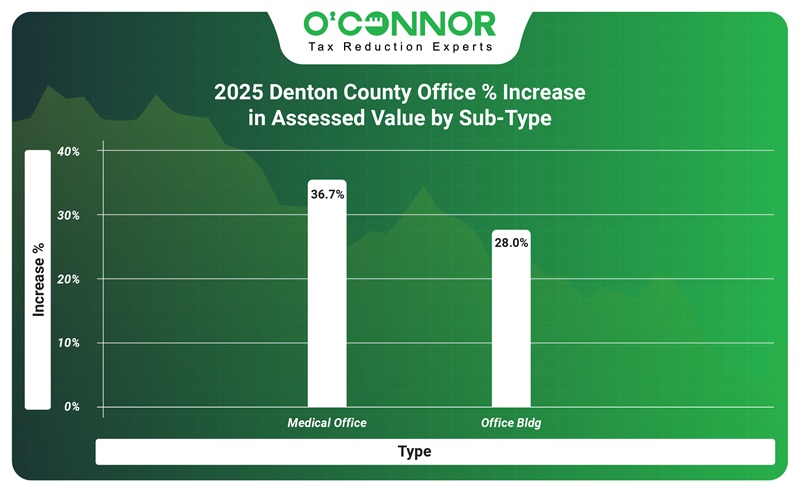
For office property, there are two sub-types in Denton County: medical and regular office buildings. Medical offices had the highest increase of 36.7%, rising from $826 million to $1.130 billion. Regular office buildings grew by 28%, from $4 billion to $5 billion.
Denton CAD Retail Tax Assessments Increased by 24.4% in 2025
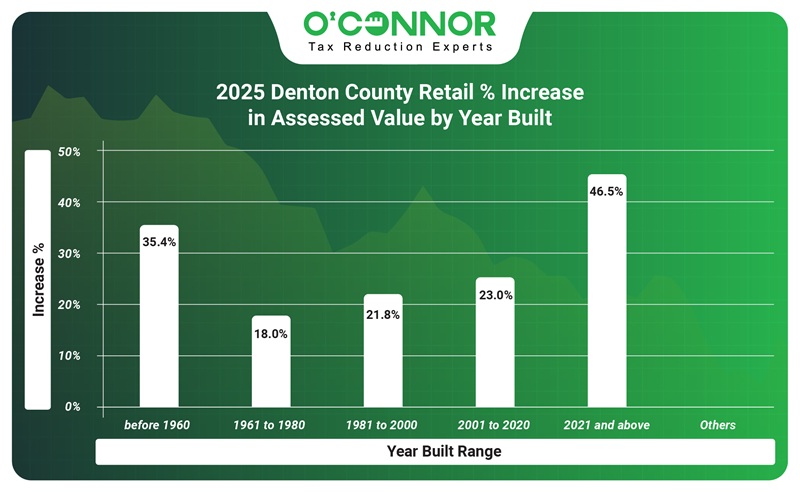
Property tax assessments for retail buildings in Denton County all increased regardless of the year built, ranging from 18 to 46.5%. The greatest increase was shown in retail property built in 2021 and later with 46.5% and the lowest was shown in property built between 1961 to 1980 with 18%. The market value grew from $4.310 billion in 2024 to $5.362 billion in 2025.
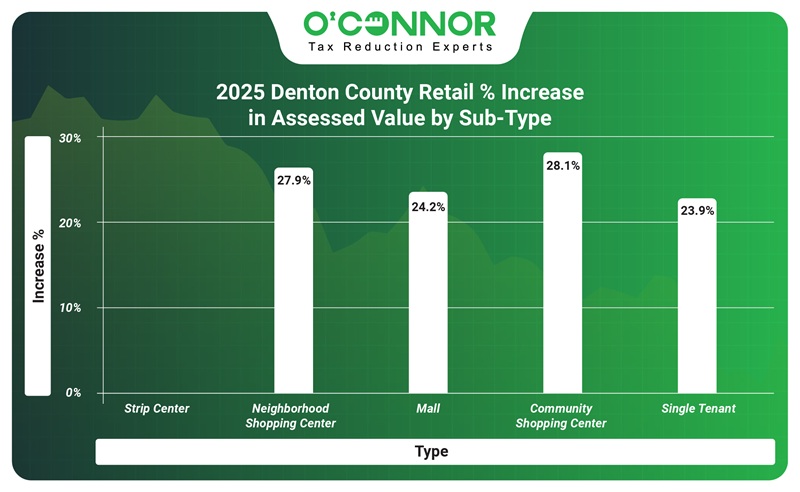
Property tax assessments rose for sub-types of retail properties in Denton County. The market value increases are in a similar range for each type of retail property, growing from 23.9 to 28.1%. The lowest increase of 23.9% belongs to single tenant property, while the greatest increase were malls with 28.1%.
Warehouses in Denton County Experienced 34.9% in Total Tax Assessments for 2025
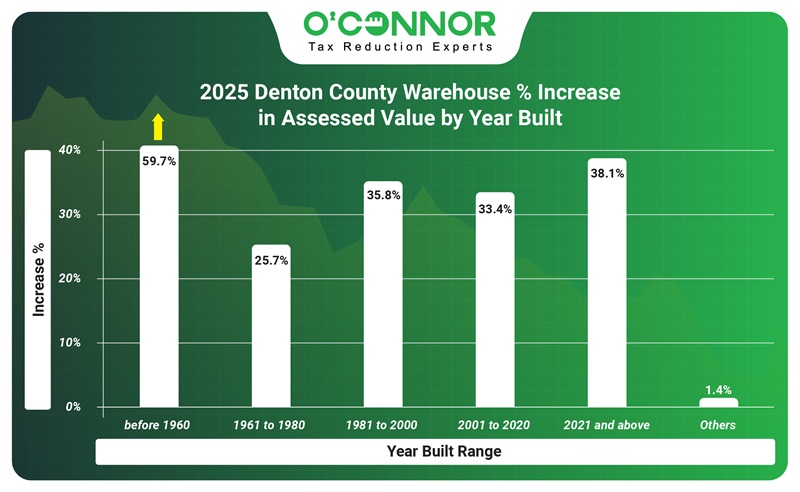
Regardless of the year built, Denton County warehouse owners experienced high increases, especially those whose property was built before 1960. Warehouse property built before 1960 saw a massive increase of 59.7%. Although this property category had the highest increase, the 2025 notice market value was only $30 million. Warehouses built in 2021 and later also saw a high increase of 38.1%, growing from $2.800 billion to $3.866 billion.

Denton CAD calculates market values for two types of warehouse properties: mini-warehouses and regular warehouses. Mini warehouses increased by 35.3% and regular warehouses by 34.9% increase. The overall market value grew from $10.959 billion to $14.788 billion.
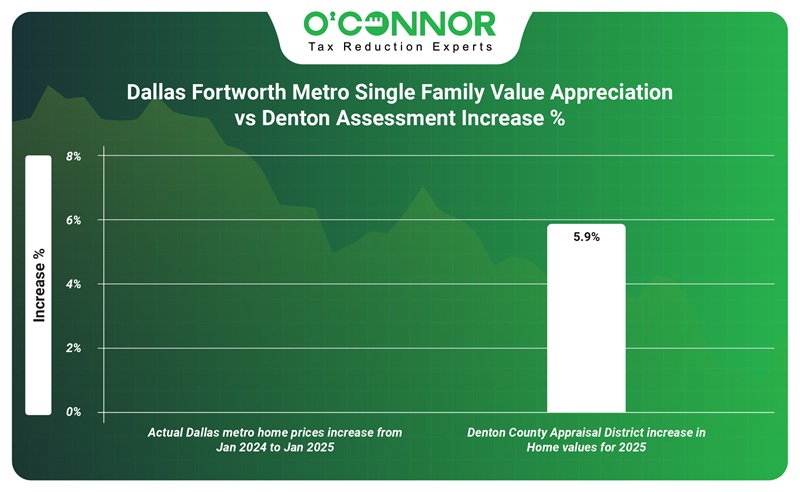
There was a 0.3% rise in Dallas metro house prices over the last year, compared to a 5.9% increase in Denton CAD.
Summary for Denton CAD 2025 Property Tax Revaluation
In Denton County, residential property owners saw relatively modest appraisal increases, while commercial properties faced substantial hikes. On average, home values rose by 5.9% across various price ranges, square footage categories, and construction years. Data from Denton CAD shows that just 36% of residential properties — about 4,463 homes — were assessed above market value, while the majority, 64%, were appraised at or below market rates. Commercial properties, however, experienced a much steeper average increase of 26.4%, considering factors such as property type, value range, and year built.
Texas property owners, including those in Denton County, have the right to appeal their property assessments. The protest process provides an opportunity for both residential and commercial owners to submit evidence that their valuations are excessive. With over five decades of experience, O’Connor is a trusted leader in property tax appeals, committed to helping owners reduce their property taxes through proven and cost-effective strategies.

